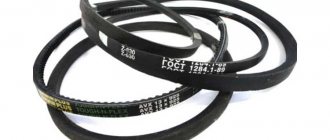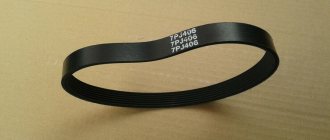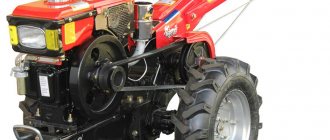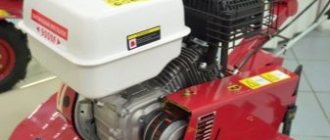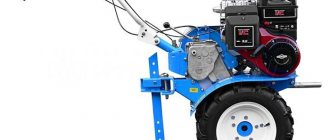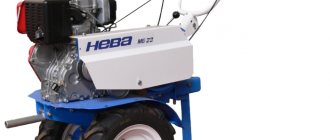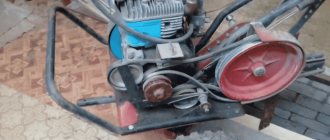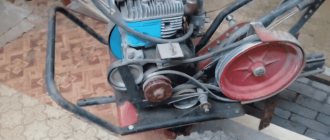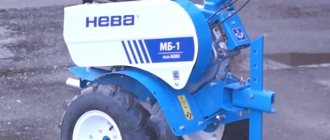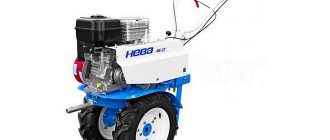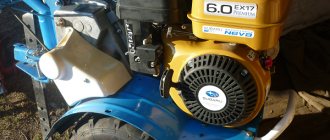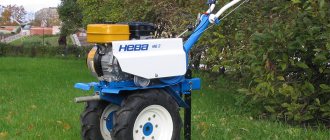Currently, there are various specialized equipment for agriculture. In this case we are talking about walk-behind tractors. These devices are used to plow the soil. Due to constant use under load, the structural integrity of the devices is compromised, as a result of which the equipment must be repaired.
Often the alternator belt fails during operation. Here you need to find out in detail about the belt for the Neva walk-behind tractor under the number MB-2, and also clarify its size. The special equipment in question is very popular among Russian farmers, which is why options for similar parts will be considered specifically for these walk-behind tractors.
You can change the alternator belt yourself
Belts for Neva walk-behind tractors
The design of special equipment from this manufacturer implies the presence of two shafts at once (crankshaft and camshaft). Both elements are driven by tension belts. Depending on the design, a chain or conventional system is used to transmit torque. In the first case, rotation is transmitted due to built-in sprockets. In the second case - due to frictional force. Let's look at the main differences between the belts used for Neva walk-behind tractors:
- Difference in location (forward gear, for reverse gear, for the drive part).
- The drive belt for the Neva walk-behind tractor varies in cross-sectional shape (toothed, V-belt, flat, round).
- Distinctive features based on the type of arrangement of the shaft and belt (angular, open transmission, semi-cross).
- There are also differences in the material used (regular strong fishing line covered with compacted rubber and a protective coating).
- Distinctive dimensional features (this parameter is measured by internal and external diameters).
In this video you will learn how to replace a belt: Depending on these characteristics, a transmission device is selected that will distribute the generated torque.
Important! Typically, Neva vehicles are equipped with MB-2 models, which have a wedge cross-section. These devices are characterized by high efficiency and, in addition, improved transmission capacity.
Technical parameters of various modifications
Motoblocks of all manufacturers, be it Neva, Ural motor vehicles with a UMZ-5V engine or Hyundai T-500, Euro-5 and many others, are produced almost according to the same scheme. Only in certain episodes we talk about different powers and available functions. The manufacturer "Neva" made the upper camshaft placement. As a result of the use of an air cooling system, belts for motorcycles need to be purchased less frequently.
In the Cascade model line, the emphasis is on the use of belt drives. The owner of the equipment must select belts for motor vehicles in strict accordance with the technical specifications of the manufacturer. The slightest deviation from the prescribed requirements will cause rapid wear of the mechanical elements. In essence, similar conditions are imposed on the Zubr units.
It is worth mentioning the “Mole” unit, in which the belt drive is used in the same model A-710, A-750, where the length is 710-750 mm, width 13 mm, and the procedure for replacing them is similar to the “Cascade”.
Walk-behind tractors are endowed with high power, which imposes specific restrictions on the permissible types of machine belts. It is strongly recommended to focus on products labeled A-1180. In the event of unscheduled or scheduled repairs, a flexible belt drive element with similar parameters is purchased.
Chinese-made walk-behind tractors are characterized by very great freedom when choosing a belt.
Belts of units for motor vehicles, as well as for attachments, for example, a belt pump, are selected taking into account only one condition: the length and strength of the product cannot differ by +/- 1.5% from the prototype. In this case, the use of analogues will not provoke repeated failure.
Selecting belt models for walk-behind tractors
In order to choose the right mechanism for your Neva walk-behind tractor, you need to follow a number of recommendations given by the manufacturer, as well as by experienced owners of special agricultural equipment. Let's consider the main points that you should pay attention to when choosing:
- first of all, the length of the belt used is taken into account (depending on the model of equipment, this parameter may change);
- when choosing, it is important to pay attention to the manufacturer (it is not recommended to purchase products from unknown brands);
- also, when selecting, pay attention to the cost (here we are talking about original spare parts, not analogues);
- It is not recommended to choose too cheap models, as there is a possibility of running into a low-quality product;
- before purchasing, you need to carefully study the number of the device that was previously installed on the walk-behind tractor;
- the same belt is purchased as it was installed (the same length of the belt being replaced and the belt being purchased);
- you should not try to compare the tension of two copies, since the old model stretches during operation;
- Experienced owners recommend using a second belt on a Neva walk-behind tractor from a manufacturer of wedge shape and cross section.
There are several criteria for choosing a belt.
Despite all these conditions for selection, the owner of special equipment must first understand the model of the mechanism used, and then decide for himself which replacement to choose. Since the characteristic features of using equipment imply the use of various spare parts for walk-behind tractors.
Important! When selecting a mechanism responsible for transmitting torque, you should not contact the first spare parts store you come across, as you may run into selling a low-quality product.
Recommendations for use
To ensure that the components for the Cascade walk-behind tractor wear out less, it is used carefully. Experienced summer residents advise:
- check the mini-tractor for defects upon purchase;
- carefully read the attached instructions in order to properly use and store the equipment;
- do not bend or stretch parts;
- do not keep the device in conditions of high humidity;
- Before use, sometimes check the pulley to remove scratches, chips, and cracks;
- buy components only in reliable stores, choosing parts intended for a specific model and produced by the manufacturer of the agricultural machine;
- When one of the belts wears out, change the front and rear belts at once so that their condition is the same.
If the work to be done on the site is simple, it is recommended to loosen the parts. This will extend the life of the walk-behind tractor.
What types of belts for walk-behind tractors exist?
Today, there are only three separate types of such mechanisms on sale. Let's look at their names, as well as the characteristic features inherent in each of the specimens under consideration:
- V-belt for Neva brand walk-behind tractor (here we are talking about the most common models that have built-in transverse wedges, which ensure continuous rotation);
- devices for the forward movement of the walk-behind tractor (in this case we are talking about transmission mechanisms, due to which the torque is redirected to the axis of the special equipment and forward movement is performed);
- belts for reverse (these mechanisms are used to transmit torque to the axle of special equipment, which ensures that the walk-behind tractor moves in the opposite direction).
In each individual case, before purchasing a tensioning device, you need to find out whether the selected option matches the model used. It should be understood that it is not recommended to use an old worn-out belt when choosing, since its dimensions and other distinctive features will not correspond to reality.
Important! When choosing this structural element, it is necessary to select a model that is produced directly for the special equipment used. Data about this is publicly available on the manufacturer’s website or on the Internet on third-party resources dedicated to special equipment.
Varieties
Unit belts are:
- wedge;
- toothed;
- forward travel;
- reverse.
To ensure optimal tension and long service life of not only the entire belt drive, but also the transmission, the size of the unit belt must be precisely selected for a specific modification of the walk-behind tractor. If you place extremely long products, as well as very short ones, they will wear out quite quickly and create an extra load on the engine or gearbox. For example, a 750 mm “Mole” belt drive is installed on units with a domestic engine.
In addition to the above, before purchasing, you need to check the outside of the product: the belt should not have damage, scratches, protruding threads, or kinks. A high-quality product is one that retains a distinct factory pattern and cannot be stretched by hand.
Belt sizes for the Neva walk-behind tractor
When selecting the appropriate consumables, it is important to determine the number of the belt installed on the model of the Neva walk-behind tractor. To do this, the following recommended measures should be taken:
- the old consumable element is removed from the walk-behind tractor using a special tool and technology;
- then the device is checked for the presence of numbers (usually there are values on the outer surface);
- As a rule, the belt number used for a Neva walk-behind tractor is white, blue or orange;
- if these figures are missing due to long-term use of special equipment, then the distance between the rotating elements is measured;
- Next, you should use a special table (a table with values is available on the manufacturer’s website) to determine the size;
- also, if necessary, you can check the required parameter with the seller, since this data is also available in stores;
- then the same model is purchased, which will be freely mounted on rotating mechanisms.
Don’t forget to choose the right belt size.
It is recommended that after purchasing a new consumable item, copy the number from its surface so that you do not have to look for the values again later. The cost of this element is quite high, which is why you should have accurate information.
Important! Only after the appropriate model for the drive mechanism has been selected can you begin to replace the device (when using a device of a different size, there is a risk of damaging not only the structural integrity of the consumable element, but also the operation of the drive mechanisms can be disrupted).
Lighting
The most popular modifications, unfortunately, are not yet equipped with a headlight, but some equipment owners themselves regulate this nuance.
It is very easy to make lighting on a walk-behind tractor; a basic electric generator is usually used for this. The connection is made as follows:
- a device that generates electricity is connected to a button on the steering wheel;
- lay the necessary wires from the button to the electrical equipment (for example, a headlight);
- the wires are insulated in any way from mechanical damage and water (most often a corrugated pipe is used).
If the generator power is sufficient, the headlight will be bright. If there is insufficient power at low engine speeds, the light will go out. Some craftsmen replace the walk-behind tractor generator with a car or tractor generator.
How to make a light for a walk-behind tractor or mini tractor with your own hands:
In any case, even without using a generator, you can make light on a walk-behind tractor. All you need is a 12-volt battery and an LED lamp. The battery can be taken from an electric bike or scooter.
It is recommended to place it between the gearbox and the engine. According to the diagram above with an electric generator, connect the battery. The wires from the battery are routed to a switch and then to a headlight or other electrical equipment.
How to tighten the belt on the Neva MB-2 walk-behind tractor with your own hands (video)
In order to replace this structural element, you do not need to contact a specialized service. All work can be done independently in a fairly short period of time. Let's consider a step-by-step algorithm of actions with which the belt is replaced on a Neva walk-behind tractor:
- first of all, it is necessary to dismantle the old consumable element, if this has not been done previously;
- in general, dismantling begins with the gradual disconnection of the protective shield, as well as the main casing;
- it is imperative to remove the spring, due to the work of which the tension is carried out;
- then the screw fasteners are unscrewed, and the stops holding the drive belt on the motor pulley are also unscrewed;
- Next, you need to make sure that the handles of the motor shaft, as well as the gearbox, are in the same plane;
- here a slight discrepancy is allowed, which does not exceed the minimum value of 0.1 millimeters;
- if necessary, the pulleys should be adjusted (to do this, the motor moves in the longitudinal plane);
- after this, it is necessary to adjust the tension pulley so that sufficient tension subsequently arises;
- At the end of the procedure, a new belt is installed (they begin to put on the element from the gear part).
After this, you need to perform the procedure in reverse order that preceded the procedure for installing a new belt on a Neva walk-behind tractor.
Important! When performing work, everything must be done carefully and step by step, otherwise there is a risk that the new consumable element will break or the drive mechanisms will be damaged.
Belting
To choose the right belt for your motorcycle, you should have the following information:
- type of drive belt suitable specifically for your modification of the unit;
- its length;
- tension level;
- type of V-belt drive (for specific models).
How to adjust the belt on the Neva MB-2 walk-behind tractor
After this consumable has been replaced, the belt on the Neva walk-behind tractor is additionally tensioned. Let us consider in detail how to perform this procedure step by step:
- First of all, you need to inspect the pulleys for contamination (if necessary, eliminate these points).
- Using a special wrench, you need to unscrew the nuts, which will free the motor part.
- Next, you need to take a 19mm wrench and install it on the threads of the existing adjusting bolt.
- By means of appropriate rotations the motor part can be brought closer or further away.
- When tensioning, do not overtighten the belt, otherwise it will cost the motor pulley bearing.
- It is imperative to check for misalignment (quite common in special equipment of this model).
- At the end, the adjusting nut is turned in the opposite direction, which allows you to leave the belt movable.
- To complete the procedure for adjusting the belt on the Neva walk-behind tractor, all that remains is to fix the four nuts that were previously removed.
This is interesting: lugs for the Neva MB 2 walk-behind tractor.
As a rule, a poorly tensioned consumable element can lead to a number of unpleasant consequences. Let's consider the main situations that threaten this moment:
- Strong vibration will be transmitted to one of the sides of the special equipment, which can subsequently damage the walk-behind tractor.
- There will be slippage, which makes it difficult to move when plowing the soil, hilling or other operation of the device.
- A loose walk-behind tractor belt can cause the engine to smoke at idle.
- Also, a bluish coating may form on the walk-behind tractor pulleys, which will gradually damage their integrity.
If you adjust the tension appropriately, you can avoid all these situations. In addition, adjustment measures are carried out quite easily and quickly, and also do not require special knowledge in the design of special equipment.
Important! After replacing and adjusting the consumables, running-in is mandatory. At the very beginning, application of a load is not allowed, otherwise the new, mounted part may break or other structural elements may be damaged.
Tags : tension, modifications, other, clutch, types, drive, unit, V-belt, technical, roller, features, place, screws, used, marking, check, section, power, remove, remove, provides, different, condition, cultivators, smoothly, oils, wear, instructions, differ, work, users, level, tractors, belt, fastening, term, breakdowns, friends, a little, opportunity, liked, articles, plowing, traces, carefully, average, unscrew, small, any
Replacement and adjustment
The flexible belt drive element on the walk-behind tractor can be replaced and adjusted independently.
The V-belt drive reliably transmits the force from the motor, but over time the belt wears out, cracks and tears form on it.
The task of changing it appears. This can be done in special service centers. This is the most correct choice, but it will not be cheap. You can carry out the replacement yourself, and if you have ever repaired your car, you have experience working with equipment.
Removing the used flexible element
First of all, remove the plastic safety cover by unscrewing the fixing nuts. Afterwards, the accessory belt is removed by relaxing the tension between the pulley (friction wheel) of the gearbox and the motor.
Some modifications have specialized devices for tensioning and loosening belts. But usually walk-behind tractors do not have this mechanism. To loosen the tension of the drive belt, loosen the motor fixing nuts (4 pieces) and move it to the right. Then we remove the belt. Don’t forget, you can only move the motor to the right (to the left) to tighten (loosen) the product within 20 millimeters.
We put on new products
We install the new accessory belt in the reverse order. Then you need to tighten it, taking into account the obligatory sagging of 10-12 millimeters. We definitely check the alignment of the friction wheels of the gearbox and motor. We tighten the motor mounting nuts diagonally.
When not in operation, the belt should rotate without difficulty on the input shaft, but not jump off it. To bring the accessory belt into working status, the clutch handle is squeezed out, the cable lifts the pressure shaft upward, tensioning the belt.
Self tension
When the new product and the loop former (damper) are installed, they need to be tensioned and adjusted, since the belt will immediately sag, which is considered unacceptable. This can shorten the duration of its use, the wheels will begin to slip, and the engine will begin to smoke at idle.
To perform the tension, you need to clean the friction wheel with a rag, and also loosen the bolts securing the motor to the chassis; use an 18mm wrench to turn the adjusting bolt in the direction of movement of the clock hand, tightening the device. At the same time, you need to try tensioning the drive belt with your second hand so that it springs freely. If you overtighten it, this will also have a detrimental effect on the reliability of the bearing and belt.
Upon completion of installation and tensioning, it is necessary to check for distortions. The new product must stand straight and have no kinks or distortions.
Each owner of a walk-behind tractor needs to know what characteristics the belt used to operate the device has. Neva units have some special features, so this should be taken into account when choosing a new belt for a walk-behind tractor.
When purchasing a part, you must carefully study the instructions provided with the equipment.
Carburetor problems
The carburetor of the walk-behind tractor may be dirty, and in many cases it may not be adjusted correctly. If this happens, then such a unit is removed and cleaned, its adjustment is carried out, which should be provided for by the rules:
- Another problem may arise, which is expressed in the fact that air does not flow into the carburetor in full. This can happen due to a clogged air filter; ultimately, the fuel mixture comes out over-rich. During use, you should periodically clean the special filter to prevent such problems from occurring. However, if the equipment is used in very dusty conditions, more frequent cleaning may be necessary.
- You should consider the condition of your air filter. Depending on the material in the base, it is necessary to rid the part of dirt using one of the effective methods. If the carburetor of the device begins to receive air in small quantities, then it may be necessary to clean the paper filter, which is done by lightly tapping or blowing.
- If you have a foam filter, you can wash it and then dry it completely. The mesh filter can be cleaned with a vacuum cleaner. Such parts have their own expiration date; as soon as it is used up, the unit will need to be replaced.
So you have learned how to repair the Cascade walk-behind tractor.
Auto mechanic, specializes in agricultural equipment
Malfunctions that may occur in the Cascade walk-behind tractor can be divided into several main categories, some of them are:
- Various problems with the motor.
- Malfunctions in other components and mechanisms of the walk-behind tractor.
If you have a Cascade walk-behind tractor, then when using this equipment you may experience problems with the motor over a certain period of time. The Cascade walk-behind tractor repair manual provides an excellent opportunity for the owner of this equipment to repair any faults that have arisen as quickly and correctly as possible, taking into account all available recommendations from the manufacturer.
Don't forget to monitor the condition of your equipment
Run-in
After installing a new product, it is necessary to run in the walk-behind tractor without putting a load on it, so as not to damage the structural elements. When using the unit, it is necessary to tighten the gear mechanisms after every 25 hours of operation. This will prevent rapid wear of the friction wheels and ensure smooth movement of the walk-behind tractor itself.
To learn how to change the belt on a walk-behind tractor, see the following video.
Motoblocks of the Neva series are an indispensable assistant in the garden. Performing many functions, with frequent use they experience considerable overloads, which contribute to the occurrence of malfunctions. Among the possible problems that can occur with a Neva-type cultivator, users often encounter broken transmission belts.
Distance from service centers, the need to quickly resume operation of the unit and the desire to save money on specialist consultations encourage self-repair of the cultivator at home. To implement it successfully, you will need little, as you will see by reading this material.
